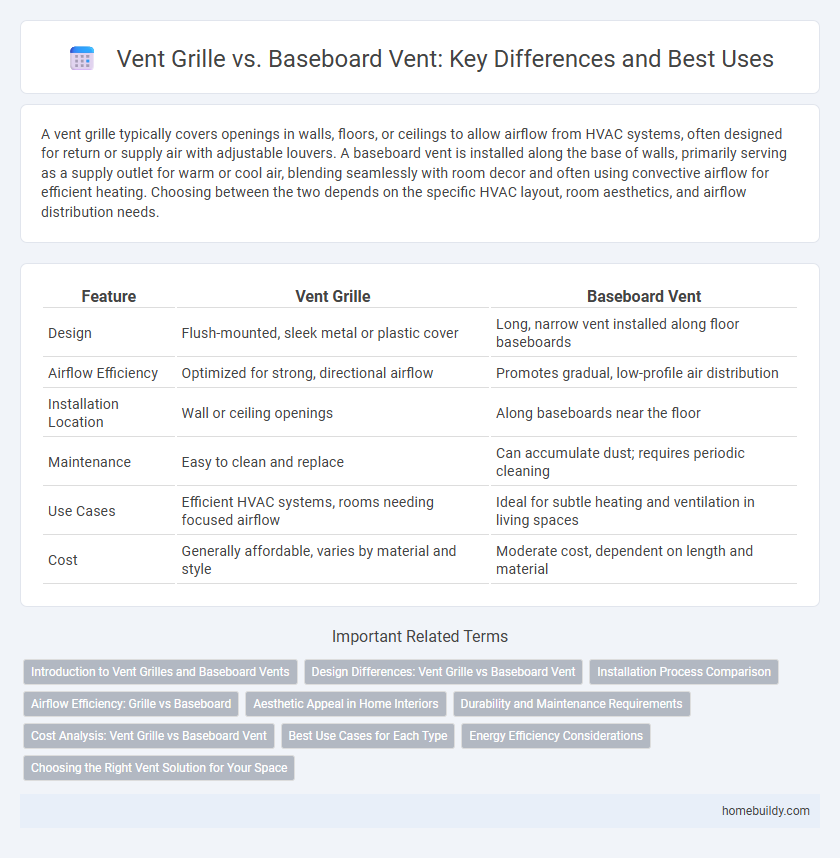A vent grille typically covers openings in walls, floors, or ceilings to allow airflow from HVAC systems, often designed for return or supply air with adjustable louvers. A baseboard vent is installed along the base of walls, primarily serving as a supply outlet for warm or cool air, blending seamlessly with room decor and often using convective airflow for efficient heating. Choosing between the two depends on the specific HVAC layout, room aesthetics, and airflow distribution needs.
Table of Comparison
| Feature | Vent Grille | Baseboard Vent |
|---|---|---|
| Design | Flush-mounted, sleek metal or plastic cover | Long, narrow vent installed along floor baseboards |
| Airflow Efficiency | Optimized for strong, directional airflow | Promotes gradual, low-profile air distribution |
| Installation Location | Wall or ceiling openings | Along baseboards near the floor |
| Maintenance | Easy to clean and replace | Can accumulate dust; requires periodic cleaning |
| Use Cases | Efficient HVAC systems, rooms needing focused airflow | Ideal for subtle heating and ventilation in living spaces |
| Cost | Generally affordable, varies by material and style | Moderate cost, dependent on length and material |
Introduction to Vent Grilles and Baseboard Vents
Vent grilles serve as essential components in HVAC systems, facilitating airflow control while enhancing indoor air quality and energy efficiency. Baseboard vents, installed at floor level, provide targeted heating and cooling by distributing air along walls, often improving room comfort in colder climates. Comparing vent grilles with baseboard vents reveals differences in design, airflow direction, and installation, influencing overall system performance and aesthetic integration.
Design Differences: Vent Grille vs Baseboard Vent
Vent grilles typically feature a flat, sleek design with adjustable louvers for directing airflow, making them suitable for wall or ceiling installation. Baseboard vents are designed with a taller profile and often include a metal or wood frame that integrates into the baseboard for a seamless, low-profile appearance. The primary design difference lies in their placement and aesthetic integration, with vent grilles emphasizing airflow control and baseboard vents focusing on subtle room perimeter installation.
Installation Process Comparison
The installation process of a vent grille typically involves securing the grille directly onto duct openings or wall cutouts with screws or clips, requiring minimal wall modifications. In contrast, baseboard vents demand careful alignment with baseboard cavities and precise cuts within the baseboard trim, often making installation more labor-intensive and time-consuming. Vent grilles offer greater flexibility in placement and easier replacement, enhancing overall installation efficiency compared to baseboard vent systems.
Airflow Efficiency: Grille vs Baseboard
Vent grilles offer superior airflow efficiency compared to baseboard vents by allowing larger volumes of air to circulate freely through their wider openings and strategically placed louvers. This design reduces resistance and improves ventilation, ensuring more effective heating or cooling distribution throughout the space. Baseboard vents often restrict airflow due to their narrow, linear layout, which can lead to uneven temperature control and reduced system performance.
Aesthetic Appeal in Home Interiors
Vent grilles offer a sleek, minimalist design that seamlessly integrates with modern home interiors, enhancing aesthetic appeal without drawing attention. In contrast, baseboard vents tend to be bulkier and more visible, often disrupting the clean lines of a room's decor. Choosing vent grilles allows for greater customization in materials and finishes, providing a subtle yet stylish solution for air distribution.
Durability and Maintenance Requirements
Vent grilles typically offer greater durability compared to baseboard vents due to their robust metal or high-quality plastic construction, which resists wear and corrosion over time. Maintenance for vent grilles is generally simpler, requiring only occasional dusting or vacuuming, while baseboard vents often accumulate more dirt and may need regular removal and cleaning to prevent blockages. Choosing vent grilles can reduce long-term upkeep and extend the life of HVAC components by ensuring consistent airflow with less risk of damage.
Cost Analysis: Vent Grille vs Baseboard Vent
Vent grilles generally offer lower upfront costs and simpler installation compared to baseboard vents, making them a cost-effective choice for many HVAC systems. Baseboard vents often require more extensive modifications to existing baseboards, which can increase labor and material expenses. Over time, vent grilles may also reduce maintenance costs due to their standardized sizing and ease of replacement.
Best Use Cases for Each Type
Vent grilles are ideal for HVAC systems requiring high airflow control and aesthetic integration, commonly used in ceilings and walls to enhance ventilation efficiency in larger rooms. Baseboard vents excel in distributing heat evenly along walls, making them best suited for radiant heating systems in residential settings where space is limited and warm air circulation is essential. Selecting between vent grilles and baseboard vents depends on room size, heating method, and desired airflow direction for optimal indoor comfort.
Energy Efficiency Considerations
Vent grilles offer superior energy efficiency compared to baseboard vents by promoting better airflow and reducing heat loss through controlled air distribution. Their adjustable louvers allow precise direction of heated or cooled air, minimizing energy waste and enhancing HVAC system performance. Choosing vent grilles with high-quality materials and proper sealing further improves insulation and reduces energy consumption.
Choosing the Right Vent Solution for Your Space
Vent grilles offer enhanced airflow control and modern aesthetics compared to baseboard vents, making them ideal for spaces requiring precise temperature regulation and sleek design. Baseboard vents are typically easier to install and better suited for heating applications along walls, while vent grilles provide versatile placement options for improved ventilation efficiency. Selecting the right vent solution depends on factors such as room size, HVAC system compatibility, and desired airflow direction to optimize comfort and energy efficiency.
vent grille vs baseboard vent Infographic

 homebuildy.com
homebuildy.com